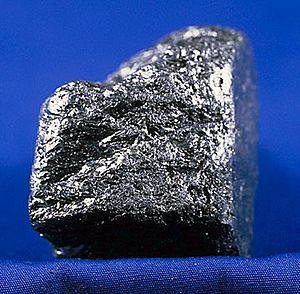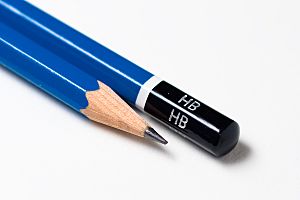Graphite facts for kids
Graphite, like diamond, is an allotrope of carbon. They are very similar to each other but the structure of the atom affects the chemical and physical properties. Graphite is made of layers of carbon atoms. These layers can slide over each other very easily. This means that it is very soft. It is a dull gray in appearance. Due to the delocalized electrons between the layers, it can conduct electricity very well.
Graphite can be formed from coal put under high heat and pressure. Also, graphite can be turned into diamond with enough heat and pressure. This is how synthetic (man-made) diamonds are made.
Graphite is naturally found in Sri Lanka,Canada and the United States. It is also called Lead Black because it looks like the metal lead. It was named by Abraham Gottlob Werner in 1789 originating from the Greek language.
It can be used as a lubricant to make mechanical devices run smoother. The most common use of graphite is the "lead" in a pencil, which also has clay.
Contents
Uses of natural graphite
Natural graphite is mostly consumed for refractories, batteries, steelmaking, expanded graphite, brake linings, foundry facings and lubricants. Graphene, which occurs naturally in graphite, has unique physical properties and is among the strongest substances known. However, the process of separating it from graphite will require more technological development.
Refractories
The use of graphite as a refractory material began before 1900 with the graphite crucible used to hold molten metal; this is now a minor part of refractories. In the mid-1980s, the carbon-magnesite brick became important, and a bit later the alumina-graphite shape. As of 2017[update] the order of importance is: alumina-graphite shapes, carbon-magnesite brick, monolithics (gunning and ramming mixes), and then crucibles.
Batteries
The use of graphite in batteries has been increasing in the last 30 years. Natural and synthetic graphite are used to construct the anode of all major battery technologies. The lithium-ion battery utilizes roughly twice the amount of graphite than lithium carbonate.
The demand for batteries, primarily nickel-metal-hydride and lithium-ion batteries, has caused a growth in graphite demand in the late 1980s and early 1990s. This growth was driven by portable electronics, such as portable CD players and power tools. Laptops, mobile phones, tablet, and smartphone products have increased the demand for batteries. Electric vehicle batteries are anticipated to increase graphite demand. As an example, a lithium-ion battery in a fully electric Nissan Leaf contains nearly 40 kg of graphite.
Steelmaking
Natural graphite in this end use mostly goes into carbon raising in molten steel, although it can be used to lubricate the dies used to extrude hot steel. Supplying carbon raisers is very competitive, therefore subject to cut-throat pricing from alternatives such as synthetic graphite powder, petroleum coke, and other forms of carbon. A carbon raiser is added to increase the carbon content of the steel to the specified level. An estimate based on USGS US graphite consumption statistics indicates that 10,500 tonnes were used in this fashion in 2005.
Brake linings
Natural amorphous and fine flake graphite are used in brake linings or brake shoes for heavier (nonautomotive) vehicles, and became important with the need to substitute for asbestos. According to the USGS, US natural graphite consumption in brake linings was 6,510 tonnes in 2005.
Foundry facings and lubricants
A foundry facing mold wash is a water-based paint of amorphous or fine flake graphite. Painting the inside of a mold with it and letting it dry leaves a fine graphite coat that will ease separation of the object cast after the hot metal has cooled. Graphite lubricants are specialty items for use at very high or very low temperatures, as forging die lubricant, an antiseize agent, a gear lubricant for mining machinery, and to lubricate locks.
Pencils
The ability to leave marks on paper and other objects gave graphite its name, given in 1789 by German mineralogist Abraham Gottlob Werner. It stems from graphein, meaning to write/draw in Ancient Greek.
From the 16th century, all pencils were made with leads of English natural graphite, but modern pencil lead is most commonly a mix of powdered graphite and clay; it was invented by Nicolas-Jacques Conté in 1795. It is chemically unrelated to the metal lead, whose ores had a similar appearance, hence the continuation of the name. Plumbago is another older term for natural graphite used for drawing, typically as a lump of the mineral without a wood casing. The term plumbago drawing is normally restricted to 17th and 18th century works, mostly portraits.
Today, pencils are still a small but significant market for natural graphite. Around 7% of the 1.1 million tonnes produced in 2011 was used to make pencils. Low-quality amorphous graphite is used and sourced mainly from China.
Other uses
Natural graphite has found uses in zinc-carbon batteries, in electric motor brushes, and various specialized applications. Graphite of various hardness or softness results in different qualities and tones when used as an artistic medium. Railroads would often mix powdered graphite with waste oil or linseed oil to create a heat-resistant protective coating for the exposed portions of a steam locomotive's boiler, such as the smokebox or lower part of the firebox.
Related pages
Images for kids
-
Graphite plates and sheets, 10–15 cm high; mineral specimen from Kimmirut, Baffin Island
-
Large graphite specimen. Naturalis Biodiversity Center, Leiden, Netherlands.
-
Scanning tunneling microscope image of graphite surface
-
Alpha graphite's unit cell
See also
 In Spanish: Grafito para niños
In Spanish: Grafito para niños













